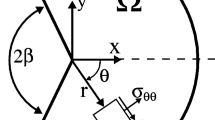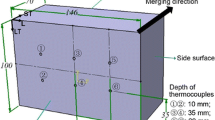Abstract
Measuring the internal stress of Al alloy forgings accurately is critical for controlling the deformation during the subsequent machine process. In this work, the crack compliance method was used to calculate the internal residual stress of Al-Cu high strength alloys, and the effect of various model parameters of crack compliance method on the calculated precision was studied by combining the numerical simulation and experimental method. The results show that the precision first increased and then decreased with increasing the crack range. The decreased precision when using a high crack range was due to the strain fluctuation during the machining process, and the optimized crack range was 71% of the thickness of forgings. Low orders of Legendre polynomial can result in residual stress curve more smooth, while high orders led to the occurrence of distortion. The Tikhonov regularization method effectively suppressed the distortion of residual stress caused by the fluctuation of strain data, which significantly improved the precision. In addition, the crack compliance method with optimized parameters was used to measure the residual stress of Al-Cu alloy with different quenching methods. The calculated results demonstrated that the distribution of residual stress was obtained accurately.
摘要
准确测量铝合金锻件内部残余应力对于控制合金后续机加工变形具有重要作用。本文采用裂纹 柔度法计算了铝铜合金锻件内部残余应力, 结合实验和仿真的方法研究了裂纹柔度法模型参数对残余 应力计算精度的影响。结果表明, 随着引入裂纹深度的增加, 计算精度先逐渐增加再逐渐降低。机加 工过程中的应变数据波动导致残余应力计算精度降低, 最优的裂纹深度范围为锻件厚度的71%。采用 低阶插值阶数会导致残余应力曲线过于平滑, 而高阶插值阶数会使残余应力曲线出现扭曲。吉洪诺夫 正则法可有效抑制应变数据波动导致残余应力曲线计算失真, 从而大幅提高计算精度。采用优化的裂 纹柔度法测量了不同淬火方式铝铜合金锻件内部残余应力, 计算结果表明使用该方法可以准确地测量 合金内部残余应力。
Similar content being viewed by others
References
ZHANG Yu-xun, YI You-ping, HUANG Shi-quan. Influence of quenching cooling rate on residual stress and tensile properties of 2A14 aluminum alloy forgings [J]. Materials science and Engineering A, 2016, 674: 658–665. DOI: https://doi.org/10.1016/j.msea.2016.08.017.
DONG Fei, YI You-ping, HUANG Cheng, HUANG Shi-quan. Influence of cryogenic deformation on second-phase particles, grain structure, and mechanical properties of Al-Cu-Mn alloy [J]. Journal of alloy and compounds, 2020, 827: 154300. DOI: https://doi.org/10.1016/j.jallcom.2020.154300.
ZHANG Tao, ZHANG Shao-hang, LI Lei. Modified constitutive model and workability of 7055 aluminum alloy in hot plastic compression [J]. Journal of Central South University, 2019, 26(11): 2930–2942. DOI: https://doi.org/10.1007/s11771-019-4225-1.
HUYNH L A T, PHAM C H, RASMUSSEN K J R. Mechanical properties and residual stresses in cold-rolled aluminum channel sections [J]. Engineering Structures, 2019, 199: 109562. DOI: https://doi.org/10.1016/j.engstruct.2019.109562.
SHUKLA S. Rapid in-line residual stress analysis from a portable two-dimensional X-ray diffractometer [J]. Measurement, 2020, 157: 107672. DOI: https://doi.org/10.1016/j.measurement.2020.107672.
ALINAGHIAN M, ALINAGHIAN I, HONARPISHEH M. Residual stress measurement of single point incremental formed Al/Cu bimetal using incremental hole-drilling method [J]. International Journal of Lightweight Materials and Manufacture, 2019, 2: 131–139. DOI: https://doi.org/10.1016/j.ijlmm.2019.04.003.
WAN Yu, JIANG Wen-chun, SONG Ming. Distribution and formation mechanism of residual stress in duplex stainless steel weld joint by neutron diffraction and electron backscatter diffraction [J]. Materials &; Design, 2019, 181: 108086. DOI: https://doi.org/10.1016/j.matdes.2019.108086.
SALEHI S D, SHOKRIEH M M. Residual stress measurement using the slitting method via a combination of eigenstrain, regularization and series truncation techniques [J]. International Journal of Mechanical Sciences, 2019, 152: 558–567. DOI: https://doi.org/10.1016/j.ijmecsci.2019.01.011.
URRIOLAGOITIA-SOSA G, ROMERO-ANGELES B, HERNANDEZ-GOMEZ L H. Crack-compliance method for assessing residual stress due to loading/unloading history: Numerical and experimental analysis [J]. Theoretical and Applied Fracture Mechanics, 2011, 56(3): 188–199. DOI: https://doi.org/10.1016/j.tafmec.2011.11.007.
VAIDYANATHAN S, FINNIE I. Determination of residual stresses from stress intensity factor measurements [J]. Journal of Basic Engineering, 1971, 93(2): 242–246. DOI: https://doi.org/10.1115/1.3425220.
CHENG W, FINNIE I. The single slice method for measurement of axisymmetric residual stresses in solid rods or hollow cylinders in the region of plane strain [J]. Journal of Engineering Materials and Technology, 1998, 120(2): 170–176. DOI: https://doi.org/10.1115/1.2807007.
TANG Zhi-tao, LIU Zhan-qiang, AI Xing. Measuring residual stresses depth profile in pre-stretched aluminum alloy plate using crack compliance method [J]. The Chinese Journal of Nonferrous Metals, 2007, 17(9): 1404–1409. DOI: https://doi.org/10.19476/j.ysxb.1004.0609.2007.09.002. (in Chinese)
LI Jing, SUN Juan. Interpolation selection and comparison in the crack compliance method [J]. Journal of Luoyang University, 2005, 20(4): 56–60. DOI: https://doi.org/10.3969/j.issn.1674-5035.2005.04.015.
OLSON M D, DEWALD A T, HILL M R. An uncertainty estimator for slitting method residual stress measurements including the influence of regularization [J]. Experimental Mechanics, 2020, 60(1): 65–79. DOI: https://doi.org/10.1007/s11340-019-00535-x.
JONES K W, BUSH R W. Investigation of residual stress relaxation in cold expanded holes by the slitting method [J]. Engineering Fracture Mechanics, 2017, 179: 213–224. DOI: https://doi.org/10.1016/j.engfracmech.2017.05.004.
ZHANG Yu-xun, YI You-ping, HUANG Shi-quan. Influence of temperature-dependent properties of aluminum alloy on evolution of plastic strain and residual stress during quenching process [J]. Metals, 2017, 7(6): 228. DOI: https://doi.org/10.3390/met7060228.
CHENG W, FINNIE I. Compliance functions for through-thickness measurement: The FEM approach [M]. Residual Stress Measurement and the Slitting Method. US: Springer, 2007. DOI: https://doi.org/10.1007/978-0-387-39030-7_4.
ROBERTO R B, CHRISTOF K, TAKATSUGU Y. Composite polymerization stress as a function of specimen configuration assessed by crack analysis and finite element analysis [J]. Dental Materials, 2013, 29(10): 1026–1033. DOI: https://doi.org/10.1016/j.dental.2013.07.012.
TIAN Zeng-feng, HU Liang-jian. Comparison of two kinds of interpolation to solve stochastic differential equations [J]. Basic Sciences Journal of Textile Universities, 2003, 16(1): 14–18. DOI: https://doi.org/10.3969/j.issn.1006-8341.2003.01.004.
PRIME M B, HILL M R. Uncertainty analysis, model error, and order selection for series-expanded, residual-stress inverse solutions [J]. Journal of Engineering Materials and Technology, 2006, 128(2): 175–185. DOI: https://doi.org/10.1115/1.2172278.
CALVETTI D, MORIGI S, REICHEL L. Tikhonov regularization and the L-curve for large discrete ill-posed problems [J]. Journal of Computational &; Applied Mathematics, 123 (1,2): 423–446. DOI: https://doi.org/10.1016/S0377-0427(00)00414-3.
ASTER R C, BORCHERS B, THURBER C H. Tikhonov Regularization [M]. Parameter Estimation and Inverse Problems. Elsevier, 2013. DOI: https://doi.org/10.1016/B978-0-12-385048-5.00004-5.
ZARZER C A. On Tikhonov regularization with non-convex sparsity constraints [J]. Inverse Problems, 2009, 25(2): 025006. DOI: https://doi.org/10.1088/0266-5611/25/2/025006.
NEUBAUER A. An a posteriori parameter choice for Tikhonov regularization in the presence of modeling error [J]. Applied Numerical Mathematics, 1998, 4(6): 507–519. DOI: https://doi.org/10.1016/0168-9274(88)90013-X.
Author information
Authors and Affiliations
Contributions
The overarching research goals were developed by DONG Fei, YI You-ping, and HUANG Shi-quan. YI You-ping contributed to the conception of the study. DONG Fei and HUANG Shi-quan designed and performed the experiments. DONG Fei performed the data analysis and wrote the manuscript. All authors replied to reviewers’ comments and revised the final version.
Corresponding authors
Additional information
Conflict of interest
DONG Fei, YI You-ping, and HUANG Shiquan declare that they have no conflict of interest.
Foundation item
Project(51875583) supported by the National Natural Science Foundation of China; Project(zzyjkt2018-03) supported by the State Key Laboratory of High Performance Complex Manufacturing, China
Rights and permissions
About this article
Cite this article
Dong, F., Yi, Yp. & Huang, Sq. Measuring internal residual stress in Al-Cu alloy forgings by crack compliance method with optimized parameters. J. Cent. South Univ. 27, 3163–3174 (2020). https://doi.org/10.1007/s11771-020-4538-0
Received:
Accepted:
Published:
Issue Date:
DOI: https://doi.org/10.1007/s11771-020-4538-0




